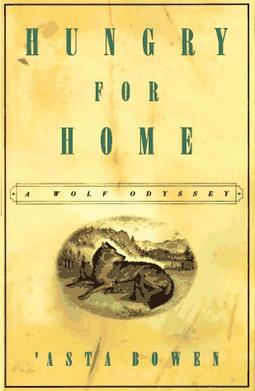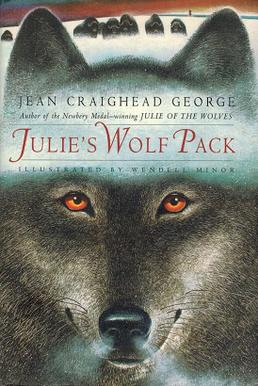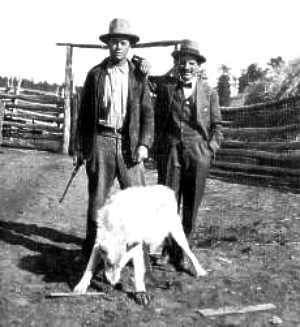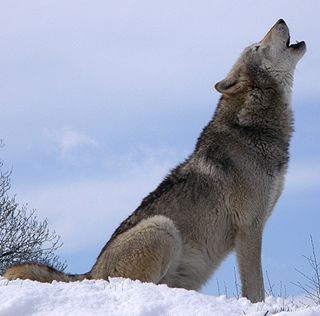
The coyote is a species of canine native to North America. It is smaller than its close relative, the wolf, and slightly smaller than the closely related eastern wolf and red wolf. It fills much of the same ecological niche as the golden jackal does in Eurasia. The coyote is larger and more predatory and was once referred to as the American jackal by a behavioral ecologist. Other historical names for the species include the prairie wolf and the brush wolf.

The wolf, also known as the gray wolf or grey wolf, is a large canine native to Eurasia and North America. More than thirty subspecies of Canis lupus have been recognized, including the dog and dingo, though gray wolves, as popularly understood, only comprise naturally-occurring wild subspecies. The wolf is the largest extant member of the family Canidae, and is further distinguished from other Canis species by its less pointed ears and muzzle, as well as a shorter torso and a longer tail. The wolf is nonetheless related closely enough to smaller Canis species, such as the coyote and the golden jackal, to produce fertile hybrids with them. The wolf's fur is usually mottled white, brown, gray, and black, although subspecies in the arctic region may be nearly all white.

White Fang is a novel by American author Jack London (1876–1916) — and the name of the book's eponymous character, a wild wolfdog. First serialized in Outing magazine between May and October 1906, it was published in book form in October 1906. The story details White Fang's journey to domestication in Yukon Territory and the Northwest Territories during the 1890s Klondike Gold Rush. It is a companion novel to London's best-known work, The Call of the Wild (1903), which is about a kidnapped, domesticated dog embracing his wild ancestry to survive and thrive in the wild.

A pack is a social group of conspecific canines. The number of members in a pack and their social behavior varies from species to species. Social structure is very important in a pack. Canine packs are led by a breeding pair, consisting of the alpha male and alpha female.

The Mexican wolf, also known as the lobo, is a subspecies of gray wolf native to southeastern Arizona and southern New Mexico in the United States, and northern Mexico. It once also ranged into western Texas. It is the smallest of North America's gray wolves, and is similar to the Great Plains wolf, though it is distinguished by its smaller, narrower skull and its darker pelt, which is yellowish-gray and heavily clouded with black over the back and tail. Its ancestors were likely the first gray wolves to enter North America after the extinction of the Beringian wolf, as indicated by its southern range and basal physical and genetic characteristics.
Jim Dutcher, is an American naturalist, cinematographer, director and author. He has written eight books and produced three wildlife films about wolves. Jim and his wife, Jamie Dutcher, are the creators of the two-time Emmy winning documentary, Wolves at Our Door, and founders of the non-profit organization, Living with Wolves. The Dutcher's are recognized as two of America's most knowledgeable experts on wolves.

Akela is a fictional character in Rudyard Kipling's stories, The Jungle Book (1894) and The Second Jungle Book (1895). He is the leader of the Seeonee pack of Indian wolves and presides over the pack's council meetings. It is at such a meeting that the pack adopts the lost child Mowgli and Akela becomes one of Mowgli's mentors.

The Jungle Book: Mowgli's Story is a 1998 American adventure film directed by Nick Marck, produced by Mark H. Orvitz and written by José Rivera and Jim Herzfeld. It is the third film adaptation by The Walt Disney Company of the Mowgli stories from The Jungle Book (1894) by Rudyard Kipling. It stars Brandon Baker, and features the voice work of Brian Doyle-Murray, Eartha Kitt, Clancy Brown, Peri Gilpin, and Sherman Howard.

The Sight is a young adult fantasy novel written by British author David Clement-Davies. It is the first novel in The Sight series, with its sequel Fell taking place after. It follows a pack of wolves cursed by a lone wolf, Morgra, whose powers foretell the destiny of one of the mother wolf's pups: Larka, a white wolf gifted with a mysterious power known as The Sight. The story follows Larka's life as she is burdened with pain and terror that comes with the prophecy, as well as seeing the viewpoints of Larka's parents, Huttser and Palla, and her adoptive brother Kar.

"Lobo, the King of Currumpaw" is the first story of author Ernest Thompson Seton's 1898 book Wild Animals I Have Known. Seton based the book on his experience hunting wolves in the Southwestern United States.

WolfQuest is a 3D wildlife simulation video game originally developed by the Minnesota Zoo and game developer company Eduweb, and developed solely by Eduweb since 2013. The game's main purpose is to help players understand wolves and the roles they play in nature by being virtually incarnated as a gray wolf themselves. WolfQuest challenges players to learn about wolf ecology by living the life of a wild wolf in Yellowstone National Park.

Alpha and Omega is a 2010 American animated adventure film directed by Anthony Bell and Ben Gluck. Starring the voices of Justin Long, Hayden Panettiere, Dennis Hopper, Danny Glover and Christina Ricci, the film was written by Christopher Denk and Steve Moore, based on a story by Moore and Gluck. This film sets around two young Rocky Mountain wolves named Kate and Humphrey who fall in love with each other, but are on the opposite ends of their pack. However, when Kate and Humphrey learn that they got relocated to Idaho for repopulation, they must work together to get back to Jasper National Park before a war slowly begins to emerge between both packs.

Wolf: The Journey Home, originally titled Hungry for Home: A Wolf Odyssey, is a 1997 American young adult novel written by 'Asta Bowen. Originally published by Simon & Schuster with line drawings by Jane Hart Meyer, it was retitled and reprinted without illustrations in 2006 by Bloomsbury Publishing. Based on true accounts of the Pleasant Valley, Montana, wolf pack, the novel traces the life of a female alpha wolf named Marta after the forced relocation of her pack in 1989 to an unfamiliar territory. Terrified, Marta abandons her pack and begins a journey in search of her home; she eventually arrives in Ninemile Valley, where she finds a new mate with whom she starts a new pack.

OR-7, also known as Journey, was a male gray wolf that was electronically tracked as he migrated from the Wallowa Mountains in the northeastern corner of the U.S. state of Oregon to the southern Cascade Range. After the wolf dispersed from his natal pack in 2011, he wandered generally southwest for more than 1,000 miles (1,600 km) through Oregon and northern California. He was the first confirmed wild wolf in western Oregon since 1947 and the first in California since 1924.

Julie's Wolf Pack is a 1997 novel written by Jean Craighead George. It is the second sequel to the Newbery Medal winner Julie of the Wolves after Julie, and the last in the Julie of the Wolves trilogy. It is the only book in the series whose story is told from the viewpoint of the wolves themselves, rather than from Julie's point of view.

Alpha and Omega is a series of animated films produced by Crest Animation Productions and distributed by Lionsgate Films. The first film was released in 2010 and featured the voices of Justin Long and Hayden Panettiere, though subsequent films were direct-to-video and therefore featured a smaller cast, primarily Ben Diskin and Kate Higgins.

The Monts de Gueret animal park — The Wolves of Chabrières is a 13 hectares public animal park located close to Guéret in the commune and the prefecture of the Creuse department, Limousin, central France.

The Custer Wolf was a North American gray wolf who was held responsible for extensive damage to ranchers' livestock in the area surrounding Custer, South Dakota, between 1911 and 1920, with the damage estimated at $25,000. The wolf was shot by a hunter employed by the federal government, who tracked the wolf for months and killed him after the wolf had triggered a trap.

In late December 2011, OR-7, a male gray wolf from Oregon, became the first confirmed wild wolf in California since 1924, when wolves were considered extirpated from the state. The first resident wolf pack was confirmed in 2015, after two adults migrated from Oregon and had five pups. Additional wolves have been tracked during their natural expansion into state, as the Cascade Range, which wolves have repopulated in Oregon, extends south into northern California. In 2021, the state had at least two wolf packs with pups for the first time in over a hundred years. It is likely that other uncollared wolves are dispersing through portions of their historic habitat in California.

Howling is a vocal form of animal communication seen in most canines, particularly wolves, coyotes, foxes, and dogs, as well as cats and some species of monkeys. Howls are lengthy sustained sounds, loud and audible over long distances, often with some variation in pitch over the length of the sound. Howling is generally used by animals that engage in this behavior to signal their positions to one another, to call the pack to assemble, or to note their territory. The behavior is occasionally copied by humans, and has been noted to have varying degrees of significance in human culture.


















